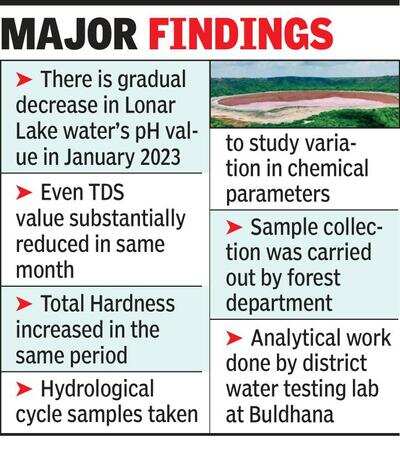Top Searches
- News
- City News
- nagpur News
- Lonar Lake pH & TDS values dropped in 2 years: Report
Lonar Lake pH & TDS values dropped in 2 years: Report

Nagpur: In yet another indication toward contamination of Lonar Lake water, Groundwater Surveys and Development Agency (GSDA), Maharashtra, has found that the potential of hydrogen (pH) (scale used to specify the acidity or basicity) and total dissolved solids (TDS) values in the water have reduced in the last two years.
“Total hardness of water has increased due to both these factors in the same period,” says the GSDA report which was submitted by amicus curiae Ravi Sanyal in the Nagpur bench of Bombay high court on Wednesday.
A division bench comprising justices Atul Chandurkar and Vrushali Joshi directed the Lonar Crater Lake Conservation Committee to take cognizance of these findings and come up with a solution in its next meeting. The HC was hearing a suo motu (SMPIL No. 3/2022) petition.
Explaining the reasons behind decrease in the lake water pH and TDS values, Sanyal said due to heavy rains in the region last year, all the groundwater sources were fully recharged, and it led to heavy percolation of normal water into the water body formed due to meteorite impact about 50,000 years ago. Quoting the GSDA report, he informed that water level was increasing in the lake at an alarming rate of 35,444 litres per hour.
The report mentioned that samples were collected in three hydrological cycles and it was observed that pH value in August 2020 was between 9.12 and 9.23. In January 2021, it was 10.9. However, in January this year, the values were in the range of 8.09 to 9.78, which is a gradual decrease compared to the last two years.
Similarly, the TDS value in August 2020 was observed between the range of 39,920 mg/litre and 45,250 mg/litre. In January 2021, the value was between 7,112 mg/litre and 9,372 mg/litre. In January 2023, the value substantially dropped between 4,210 mg/litre and 4,324 mg/litre.
On total hardness, the GSDA report said its value ranged from 160 mg/litre to 100 mg/litre in August 2020. In January 2021, it was between the range of 60 mg/litre and 100 mg/litre. In January 2023, its value was found between 148 mg/litre to 184 mg/litre.
The report mentioned that samples collected in 2008, 2013, 2019, 2020, 2021 and 2023 represent different climatic conditions, particularly with reference to factors like rainfall and temperature among others, which has to be given due consideration. “The samples of hydrological cycles were considered to study variation in chemical parameters. The collection was carried out by the forest department while the subsequent analytical work was conducted by district water testing laboratory at Buldhana,” the GSDA said.
# Major findings
* There is gradual decrease in Lonar Lake water’s pH value in January 2023
* Even TDS value substantially reduced in same month
* Total Hardness increased in the same period
* Hydrological cycle samples taken to study variation in chemical parameters
* Sample collection was carried out by forest department
* Analytical work done by district water testing lab at Buldhana
“Total hardness of water has increased due to both these factors in the same period,” says the GSDA report which was submitted by amicus curiae Ravi Sanyal in the Nagpur bench of Bombay high court on Wednesday.
A division bench comprising justices Atul Chandurkar and Vrushali Joshi directed the Lonar Crater Lake Conservation Committee to take cognizance of these findings and come up with a solution in its next meeting. The HC was hearing a suo motu (SMPIL No. 3/2022) petition.
Explaining the reasons behind decrease in the lake water pH and TDS values, Sanyal said due to heavy rains in the region last year, all the groundwater sources were fully recharged, and it led to heavy percolation of normal water into the water body formed due to meteorite impact about 50,000 years ago. Quoting the GSDA report, he informed that water level was increasing in the lake at an alarming rate of 35,444 litres per hour.
The report mentioned that samples were collected in three hydrological cycles and it was observed that pH value in August 2020 was between 9.12 and 9.23. In January 2021, it was 10.9. However, in January this year, the values were in the range of 8.09 to 9.78, which is a gradual decrease compared to the last two years.
Similarly, the TDS value in August 2020 was observed between the range of 39,920 mg/litre and 45,250 mg/litre. In January 2021, the value was between 7,112 mg/litre and 9,372 mg/litre. In January 2023, the value substantially dropped between 4,210 mg/litre and 4,324 mg/litre.
On total hardness, the GSDA report said its value ranged from 160 mg/litre to 100 mg/litre in August 2020. In January 2021, it was between the range of 60 mg/litre and 100 mg/litre. In January 2023, its value was found between 148 mg/litre to 184 mg/litre.
The report mentioned that samples collected in 2008, 2013, 2019, 2020, 2021 and 2023 represent different climatic conditions, particularly with reference to factors like rainfall and temperature among others, which has to be given due consideration. “The samples of hydrological cycles were considered to study variation in chemical parameters. The collection was carried out by the forest department while the subsequent analytical work was conducted by district water testing laboratory at Buldhana,” the GSDA said.
# Major findings
* There is gradual decrease in Lonar Lake water’s pH value in January 2023
* Even TDS value substantially reduced in same month
* Total Hardness increased in the same period
* Hydrological cycle samples taken to study variation in chemical parameters
* Sample collection was carried out by forest department
* Analytical work done by district water testing lab at Buldhana
Start a Conversation
FOLLOW US ON SOCIAL MEDIA
FacebookTwitterInstagramKOO APPYOUTUBE









